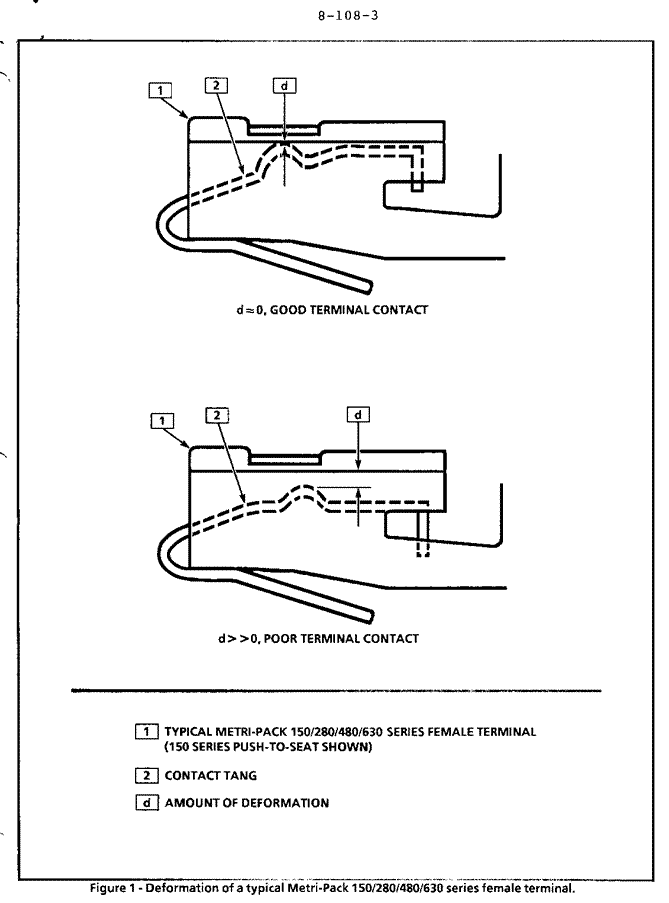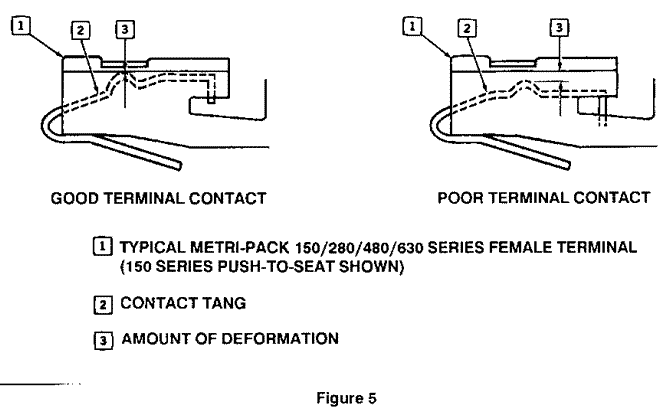
Subject: CHECKING CONNECTOR TERMINAL CONTACT - METRI - PACK
Model and Year: 1982-91 PASSENGER CARS AND TRUCKS
Source: Chevrolet Service Bulletin
Bulletin Number: 91-85-8A - (09/21/1990)
TO: ALL CHEVROLET DEALERS
When diagnosing an electrical system that utilizes Metri-Pack 150/280/480/630 series terminals (refer to Terminal Repair Kit J 38125-4 instruction manual for terminal identification), it is important to check terminal contact between a connector and component, or between in-line connectors, before replacing a suspect component.
Frequently, a diagnostic chart leads to a step that reads: "Check for poor connection or replace..." Mating terminals must be inspected to assure good terminal contact. A poor connection between the male and female terminal at a connector may be the result of contamination or deformation.
Contamination is caused by the connector halves being improperly connected, a missing or damaged connector seal, or damage to the connector itself, exposing the terminals to moisture and dirt. Contamination, usually to underhood or underbody connectors, leads to terminal corrosion, causing an open circuit or intermittently open circuit.
Deformation is caused by probing the mating side of a connector terminal without the proper adapter, improperly joining the connector halves or repeatedly separating and joining the connector halves. Deformation, usually to the female terminal contact tang, can result in poor terminal contact, see Figure 1, causing an open or intermittently open circuit.
Follow the procedure below to check terminal contact.
1. Separate the connector halves, refer to Terminal Repair Kit J 38125-4 instruction manual.
2. Inspect the connector halves for contamination. Contamination will result in a white or green build-up within the connector body or between terminals causing high terminal resistance, intermittent connection or an open circuit. An underhood or underbody connector that shows signs of contamination should be replaced in its entirety, terminals, seals and connector body.
3. Using an equivalent male terminal from the Terminal Repair Kit J 38125-2, check the retention force of the female terminal in question by inserting and removing the male terminal to the female terminal in the connector body. Good terminal contact will require a certain amount of force to separate the terminals.
4. Using an equivalent female terminal from the Terminal Repair Kit J 38125-2, compare the retention force of this terminal to the female terminal in question by joining and separating the male terminal to the good female terminal, and then joining and separating the male terminal to the female terminal in question. If the retention force is significantly different between the two female terminals, replace the female terminal in question, refer to Terminal Repair Kit J 38125-2.


General Motors bulletins are intended for use by professional technicians, not a "do-it-yourselfer". They are written to inform those technicians of conditions that may occur on some vehicles, or to provide information that could assist in the proper service of a vehicle. Properly trained technicians have the equipment, tools, safety instructions and know-how to do a job properly and safely. If a condition is described, do not assume that the bulletin applies to your vehicle, or that your vehicle will have that condition. See a General Motors dealer servicing your brand of General Motors vehicle for information on whether your vehicle may benefit from the information.
© Copyright General Motors Corporation. All Rights Reserved
Article ID: 691
Created: August 1, 2014
Last Updated: August 1, 2014
Online URL: https://www.corvetteactioncenter.com/tech/knowledgebase/article/1982-1991-corvette-service-bulletin-checking-connector-terminal-contact-metri-pack-691.html